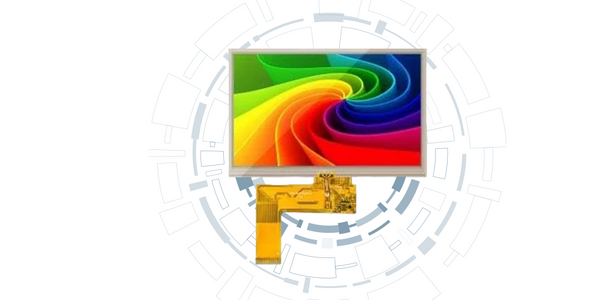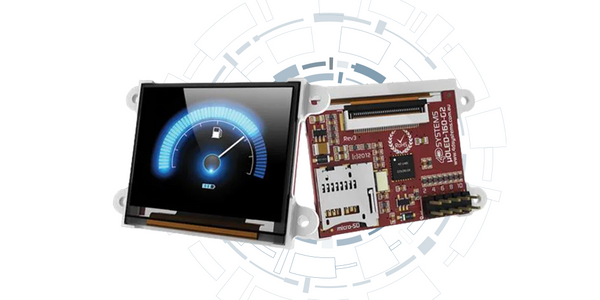Have you ever noted your screen time?
According to Alarming Average Screen Time Statistics (2024), people on average spend 6 hours and 58 minutes of screen time every day.
This proves that whether in smartphones or laptops, screens have become an inseparable part of our daily lives. But have you ever thought about what makes these screens look so different from each other?
The answer is that they are made of two distinct screens- OLED displays and LCD display.
Let’s find all the distinctions between LCD display screen and OLED displays while exploring how each technology works.
How LCD Display Screen Works:

Liquid Crystal Display or LCD technology works by using a backlight to illuminate the screen.
The display consists of liquid crystals that are sandwiched between two layers of polarizing material. When an electric current passes through these crystals, they align in such a way that they either block or allow light to pass through. Thus, the display.
This light then travels through a color filter to produce the visible image on your screen. The backlight used in an LCD is generally LED (Light Emitting Diode), providing a consistent source of illumination for the display.
How OLED Displays Work:

OLED displays function using organic materials that emit light when electricity is applied.
Each pixel in an OLED display is made of organic compounds that glow when they are electrically stimulated. This allows for thinner, more flexible displays.
As each pixel can be turned on or off individually it displays deeper blacks and thus higher contrast, without requiring a separate light source.
The end result is a vivid visual with colorful colorings and complete blacks, making OLEDs best for great screens in devices like smartphones, TVs, and wearables like watches, and many others.
OLED vs LCD Display Screen: Key Differences
When comparing OLED vs LCD show display technology, numerous prominent key differences. Each distinction impacts the consumer experience in numerous ways, Let’s have a glance.
Lighting & Contrast in OLED vs LCD:
The lighting fixtures mechanics in LCD display screen and OLED show display screen is a key element of distinction.
LCDs use a backlight to light up the display screen, with liquid crystals appearing as shutters to control the passage of light. This method even in black scenes can leak through, which leads to greyish blacks and low contrast.
OLEDs, alternatively, feature individual organic components that emit light while electricity passes through them. Their ability to completely flip off pixels consequences in actual blacks and a much higher contrast ratio.
Color Accuracy and Saturation in OLED vs LCD:
OLEDs typically provide extra bright hues and better color accuracy than LCDs.
Since OLED pixels emit their own mild, they are able to obtain extra accurate shade and deeper saturation levels.
LCDs can occasionally appear washed out or comparatively much less vibrant in evaluation.
Viewing Angles in OLED vs LCD:
OLED displays have superior viewing angles in comparison to LCDs.
With OLED, the colors and brightness of the show continue to be consistent even when considered from sharp angles.
In contrast, LCD monitors can show some shade shifting or brightness discount when now not regarded directly.
Response Time in OLED vs LCD:
OLEDs usually have quicker response times than LCDs due to the fact the organic layers in OLED presentations are tons quicker at responding to electric inputs.
This makes OLED displays better for fast-shifting pics, reducing movement blur in movies and games.
Power Consumption in OLED vs LCD:
The energy consumption dynamics range considerably between the two.
OLEDs can be more energy-efficient when displaying dark scenes because only lit pixels consume power for displaying the black light the OLED pixels simply do not glow. For the same reason displaying very bright or white screens can consume more power in OLEDs.
An LCD display screen generally uses an equal amount of power regardless of the color requirement to display because the backlight is always on.
Flexibility in OLED vs LCD:
OLEDs can be made much thinner and more flexible allowing for innovative designs like curved or bendable displays in smartphones and TVs.
LCDs comparatively are thicker due to the need for a backlight layer. Hence, they are used as flat screens rather than curved screens
Lifespan and Durability in OLED vs LCD:
OLED displays have a shorter lifespan than LCD display screen, due to the organic materials that are used degrade over time.
OLED screens are also more susceptible to burn-in. The remnants of static images can "stick" on the screen if displayed too long and can be seen as ghost photos.
LCDs being less susceptible to burn-in don’t show ghost images even when images are displayed for too long. However, LCDs can suffer from other issues like backlight failure or clouding over time.
Bottom Line
LCDs offer robustness and cost efficiency, while OLEDs excel in delivering superior contrast, color accuracy, and flexibility.
Each technology brings a set of distinct advantages to different applications, allowing users to select based on priorities like visual quality and device design.
Now that you know the difference buy the right display screen for your project now from Si Comp Hungary!

